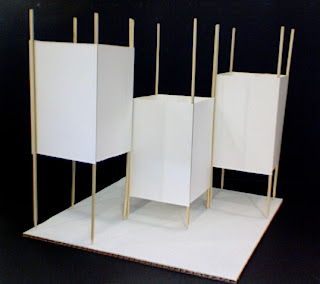 Presence: The Roman Empire began using Villas with courtyards, or halls. The courtyards were the center of the houses and framed by Doric columns. Mostly the courtyards were used to hide servants from the public eye and from being seen by neighbors. The inclusion of the hall ultimately became an integral part of residential planning as noted in manor houses of the nobility and gentry (Blakemore 69). The hall was usually two stories in height and was located at ground level or on the first floor above ground level (Blakemore 71). These uninterrupted open spaces could be expansive in influential households (Blakemore 71). Communal living was organized around the hall in early medieval houses. The lord, with his retainers and tenants, used it for sleeping, dining, recreation, administration of justice, calls to arms, ritual, reception of guests, and living room (Blakemore 71). The presence of these halls or courtyards really exemplified the Roman style and became an example for many new structures, such as castles and buildings today, but are now called parlors or family rooms.
Presence: The Roman Empire began using Villas with courtyards, or halls. The courtyards were the center of the houses and framed by Doric columns. Mostly the courtyards were used to hide servants from the public eye and from being seen by neighbors. The inclusion of the hall ultimately became an integral part of residential planning as noted in manor houses of the nobility and gentry (Blakemore 69). The hall was usually two stories in height and was located at ground level or on the first floor above ground level (Blakemore 71). These uninterrupted open spaces could be expansive in influential households (Blakemore 71). Communal living was organized around the hall in early medieval houses. The lord, with his retainers and tenants, used it for sleeping, dining, recreation, administration of justice, calls to arms, ritual, reception of guests, and living room (Blakemore 71). The presence of these halls or courtyards really exemplified the Roman style and became an example for many new structures, such as castles and buildings today, but are now called parlors or family rooms.
 Precedent: The Roman Empire used the Feudal system and Middle Ages as precedents for its own architecture. In the early Middle Ages, castles were one response to unsettled conditions under which precedence was given to fortification (Blakemore 69). The Feudal system and prevailing unsettled conditions were the major integrally related factors influencing domestic building of the Middle Ages (Blakemore 68). Precedents were used as an idea for construction. Just like for the precedent analysis, we had to choose a structure that changed architecture and gave an idea or model for future architecture.
Precedent: The Roman Empire used the Feudal system and Middle Ages as precedents for its own architecture. In the early Middle Ages, castles were one response to unsettled conditions under which precedence was given to fortification (Blakemore 69). The Feudal system and prevailing unsettled conditions were the major integrally related factors influencing domestic building of the Middle Ages (Blakemore 68). Precedents were used as an idea for construction. Just like for the precedent analysis, we had to choose a structure that changed architecture and gave an idea or model for future architecture. Moments: Moments can be characterized by the way that people interact in a space or with a form of architecture. The origin of the parlor is uncertain but it is known that early in the Middle Ages these spaces were part of the monastic dwelling; documentary evidence points to secular use of the parlor by the latter part of the 14th century (Blakemore 72). Just like the living room or the kitchen is the center of a household, the parlor was the center of all the action during the Middle Ages. While architecturally insignificant, serving rooms were highly important in the operations of the household (Blakemore 73). These included such spaces as kitchen, buttery, pantry, bake houses, slaughterhouses, brewery, etc. (Blakemore 73). The way that the people interacted in these spaces, whether by cooking or recreation, made small moments that created the atmosphere of the room around them.
Moments: Moments can be characterized by the way that people interact in a space or with a form of architecture. The origin of the parlor is uncertain but it is known that early in the Middle Ages these spaces were part of the monastic dwelling; documentary evidence points to secular use of the parlor by the latter part of the 14th century (Blakemore 72). Just like the living room or the kitchen is the center of a household, the parlor was the center of all the action during the Middle Ages. While architecturally insignificant, serving rooms were highly important in the operations of the household (Blakemore 73). These included such spaces as kitchen, buttery, pantry, bake houses, slaughterhouses, brewery, etc. (Blakemore 73). The way that the people interacted in these spaces, whether by cooking or recreation, made small moments that created the atmosphere of the room around them. Duality: Duality is the combination of two things in one, much like Roman baths were used for a gathering spot for the town and mainly for a place to bathe. Much like the pools of today, where people gather to socialize. The studio projects represented duality by the pathways exemplified and also the word that the structure is describing. For my project, I created a white spiral staircase with a black paper ribbon wrapped around it. The black represents the evil in the story “Fundevogel”, while the white staircase represents the good that is beating the black to the tip of the point. My structure shows duality by relating to the story and also creating a sense of hierarchy.
Duality: Duality is the combination of two things in one, much like Roman baths were used for a gathering spot for the town and mainly for a place to bathe. Much like the pools of today, where people gather to socialize. The studio projects represented duality by the pathways exemplified and also the word that the structure is describing. For my project, I created a white spiral staircase with a black paper ribbon wrapped around it. The black represents the evil in the story “Fundevogel”, while the white staircase represents the good that is beating the black to the tip of the point. My structure shows duality by relating to the story and also creating a sense of hierarchy. Metric: The metric system was used in the way that the Roman baths were built. They were large in scale with consideration toward the amount of people able to participate at once. The surroundings were decorated with arches that span the entire outer edge of the structure. The structure is extremely tall as seen from the scale of the people in the picture compared to the height of the walkways. These buildings are large in scale much like most Roman architecture.
Metric: The metric system was used in the way that the Roman baths were built. They were large in scale with consideration toward the amount of people able to participate at once. The surroundings were decorated with arches that span the entire outer edge of the structure. The structure is extremely tall as seen from the scale of the people in the picture compared to the height of the walkways. These buildings are large in scale much like most Roman architecture.Summary: The Romans used precedents for ideas toward structures, then the metric system and form to build the structure. Their buildings had a presence and duality that invited people to come and create moments in the space.
Cites:
http://cache.virtualtourist.com/2651060-Roman_baths_2005-Bath.jpg







































